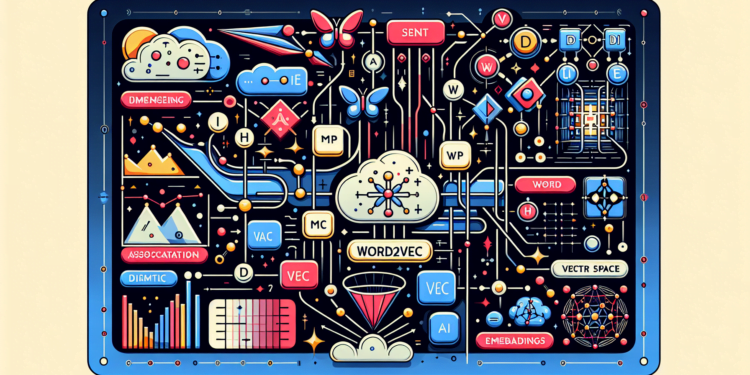The multidimensional nature of linguistic data has historically challenged machines, leading to the creation of models like Word2Vec, a natural language processing (NLP) algorithm that transforms words into vectors. This framework, developed by a team led by Tomas Mikolov at Google, revolutionizes the capturing of synergies between words in a continuous vector space, having started its operation in 2013 and based on shallow neural networks to learn word representations from large text corpora.
Theoretical Foundations of Word2Vec
The system is built on two architectures: the Continuous Bag of Words model (CBOW) and the Skip-gram model. CBOW predicts target words (e.g., ‘apple’) from surrounding context words (‘eat’, ‘green’), while Skip-gram reverses this relationship, using a target word to predict the context. Both utilize neural network structures to semantically project words into a dimensional space where vectors represent linguistic relationships.
Technical Advances and Optimizations
The initiation of Word2Vec used stochastic gradient descent training algorithms and negative sampling techniques to improve computational efficiency. Recent innovations have introduced advanced regularization and optimization methods like Adam and RMSprop, which accelerate convergence and enhance the quality of word vectors. Additionally, the implementation of subsampling of frequent words and the concept of ‘negative sampling’ have been fundamental to counteract the high frequency of common words.
Practical Applications of Word2Vec
The scope of Word2Vec’s use is extensive, ranging from improving recommendation systems to aiding in the detection of semantic and analogical similarities. Its ability to detect synonyms and cluster related words makes it valuable for automatic text categorization and semantic search. Sentiment detection and machine translation are other fields significantly benefited by the dense representations provided.
Comparison with Preceding Models
Before Word2Vec, word representations were often sparse, using one-hot encoding or high-dimensional co-occurrence matrices with a large number of zeros. In comparison, Word2Vec offers a dense, low-dimensional representation that better captures contextual relationships. The representations generated by Word2Vec have proven to be more effective in NLP tasks than previous approaches, especially in terms of computational efficiency and performance on downstream tasks.
Future Directions and Innovations
While Word2Vec continues to benefit multiple applications, research in NLP is moving towards even more sophisticated models like BERT and GPT, which incorporate attention and transformers to capture long-range dependencies. However, the relevance of Word2Vec endures in its simplicity and effectiveness. Future development might include the integration of Word2Vec into hybrid systems, combining vector efficiency with the subtlety of transformer-based models, expanding the capacity of these representations to tackle even more complex language comprehension tasks.
Case Studies
Recent research has applied Word2Vec in social network analysis to identify emerging trends and opinions, showing how word representations can reveal underlying patterns in the data. In the biomedical field, the vectorization of terms has enabled the discovery of correlations between symptoms and diseases from medical texts, providing a clear example of how AI offers an advantage in exploring extensive bodies of knowledge.
Conclusion
Word2Vec has set a standard in word representation, merging linguistic theory with advanced algorithms to create a powerful tool in NLP. The model’s ability to unravel syntax and semantics and its influence on subsequent developments in the field ensure its ongoing relevance, both as a cornerstone in language analysis and as a foundation for future innovations. As the field of AI expands and evolves, Word2Vec represents a crucial link in the evolutionary chain of natural language understanding.






















